Harbouring fantasies of woodland retreats, the desire to go off-grid is a reaction to our increasingly urbanised existence.
The modern human feels disconnected from nature, their minds overwhelmed with noise from social media, work and city life. At the same time, the contemporary explorer is more intrepid, discerning and curious – they have more money, a greater desire for experiences rather than material possessions, and unparalleled access to affordable air connectivity. They are willing to travel further, in search of greater reward.
Here are five of the world’ most remote hotels – ones chosen as much for their luxurious interiors as their architectural splendour and strong environmental approaches.
1. Juvet Landscape hotel, Norway
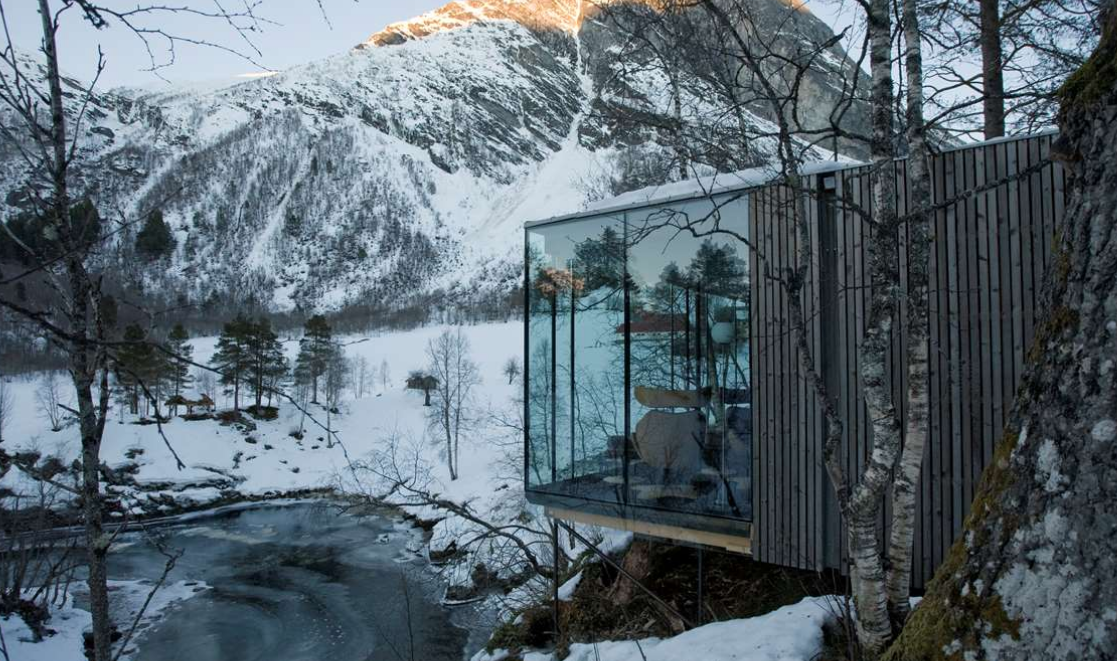 Built in 2008, and described as the first “landscape hotel” in Europe, the Juvet has set the trend for hyper-modern, minimalist architecture that is embedded sensitively into the wilderness. It had a budget of €1 million.
Built in 2008, and described as the first “landscape hotel” in Europe, the Juvet has set the trend for hyper-modern, minimalist architecture that is embedded sensitively into the wilderness. It had a budget of €1 million.
Although striking, it doesn’t dominate the natural surrounds – it uses handcrafted timber, living roofs and mirrored glass to blend in with the forest, rendering it invisible from certain angles. Set on a cliff, windows overlook a fast-flowing river, and a green wall of birch, aspen and pine trees.
It has nine detached rooms in addition to the farm’s mill, house and bar, where there are also rooms for rent. The seven “landscape” rooms occupy “glass cubes on stilts”, and have dark interiors so as not to detract from the outdoors.
In the style of traditional Norwegian log cabins, the two new single-occupancy Birdhouses are all about simplicity, measuring 8 sqm, and with just a bed and bench on which to sit. The idea is to reconnect with nature and to realise how little you need to be happy. A spa with a 15-metre wide window has a steam room and outdoor hot tub.
The Juvet Landscape hotel has already caught the attention of the movie industry – it was turned into the star location for the 2015 science fiction film Ex Machina directed by Alex Garland. The hotel and the Valldal valley itself, have been written about by numerous publications including Vanity Fair, Dezeen and Business Insider.
The Independent wrote: “Designed by Norwegian architects Jensen and Skodvin and opened five years ago, Juvet Landscape hotel has won plaudits for its organic simplicity, modern design and tranquil setting.
It was built as part of a government initiative to develop 18 National Tourist Routes throughout Norway that would improve infrastructure and introduce modern architecture – viewpoints, rest stops and accommodation – to highlight the country’s dramatic landscapes.”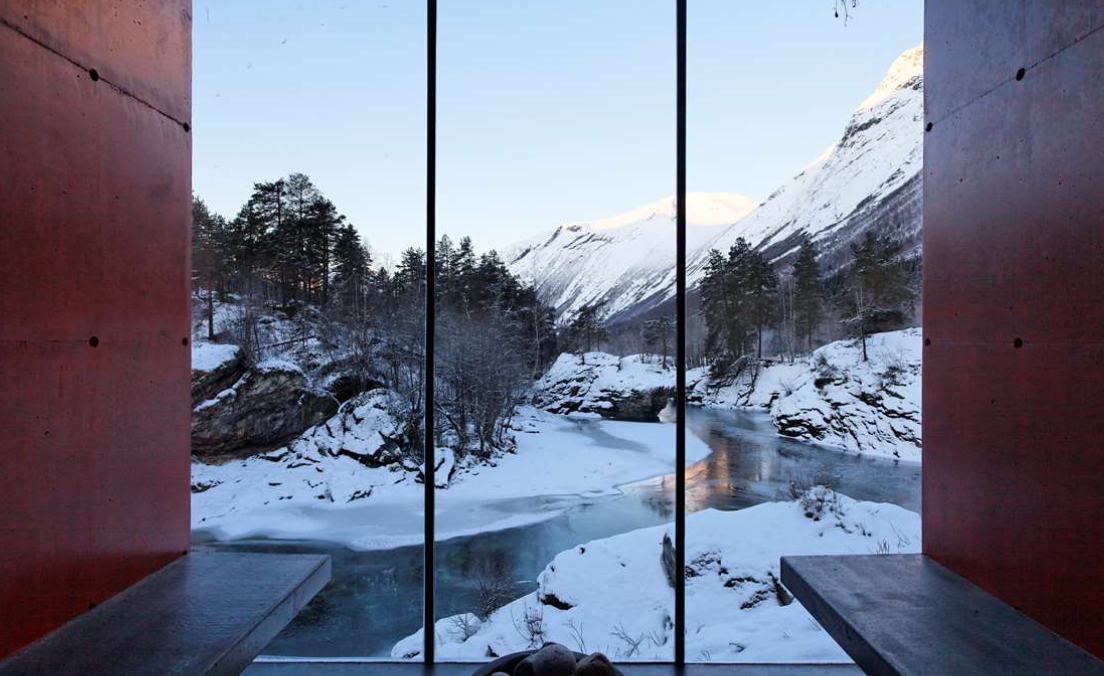 “Meals are eaten communally on a long table in an old red barn. The menu relies on local ingredients, such as bread baked by a 97-year-old lady and fruit grown on the shores of the nearby Norddals fjord.
“Meals are eaten communally on a long table in an old red barn. The menu relies on local ingredients, such as bread baked by a 97-year-old lady and fruit grown on the shores of the nearby Norddals fjord.
“[Nearby there are] ski resorts with chair lifts, such as Stranda, around 40km away. It is in the magnificent Sunnmore Alps, with impressive views over Storfjord below. With 17 different pistes and some of the best off-piste opportunities in Scandinavia, there is plenty to enjoy.”
Situated in Burtigarden farm in Alstad, Valldal, it’s seven hours from Oslo by car – so definitely counts as one of the more remote hotels here. Rates at the Juvet Landscape hotel are about £300 a night for a double room.
2. Singular, Patagonia
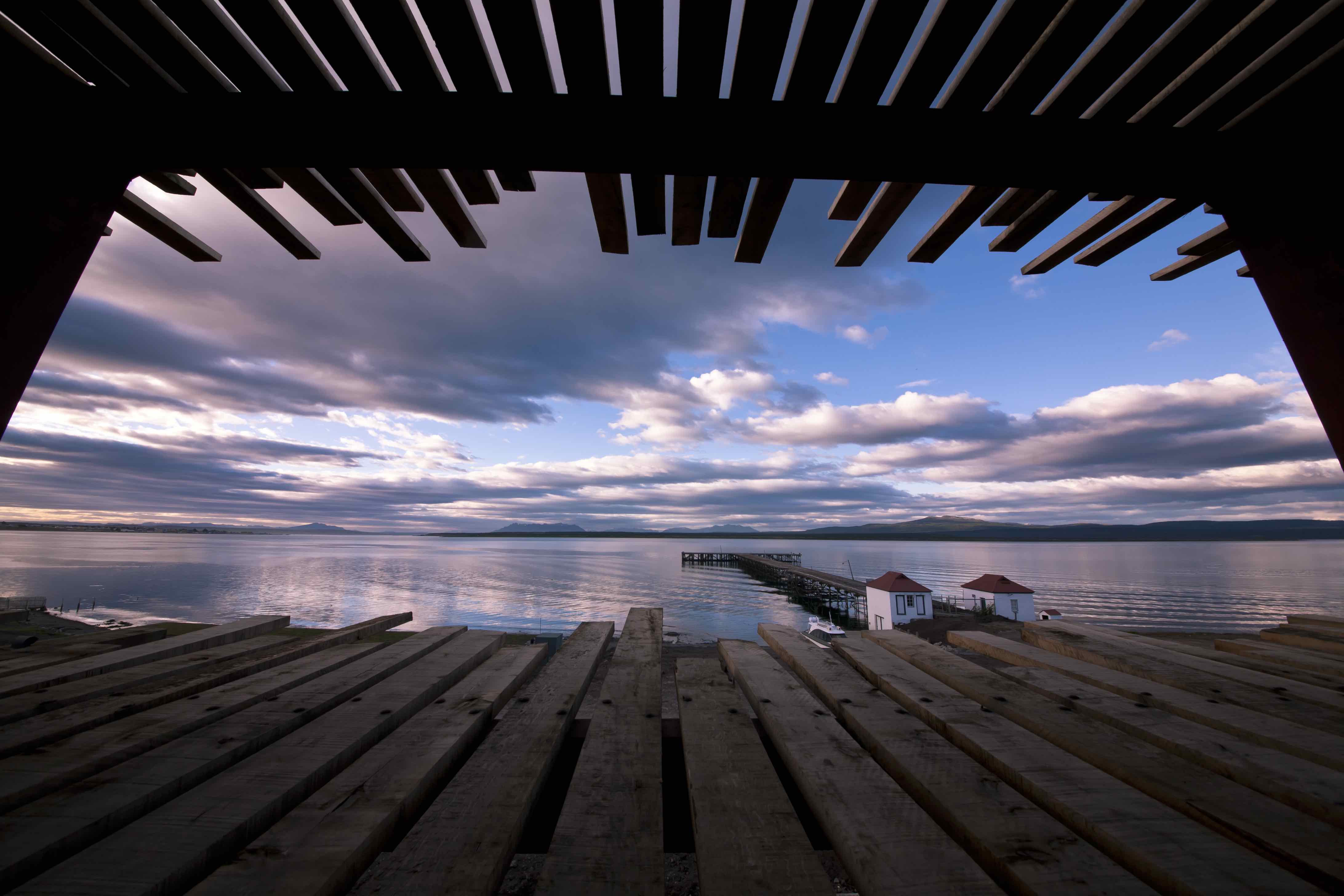 The five-star Singular Patagonia hotel is located outside Puerto Natales in Chile, on the shores of the Last Hope fjord, near Torres del Paine National Park. It is a three-hour flight from Santiago, followed by a 2.5-hour drive.
The five-star Singular Patagonia hotel is located outside Puerto Natales in Chile, on the shores of the Last Hope fjord, near Torres del Paine National Park. It is a three-hour flight from Santiago, followed by a 2.5-hour drive.
Although not a new-build, the property takes the form of a magnificent converted red-brick cold storage plant from 1915, surrounded by windswept grassland and snow-capped mountains.
Since opening in 2011, the interiors have become the ultimate in industrial chic with exposed beams, double-height ceilings, battered leather Chesterfields, concrete floors, free-hanging metal lamps and old factory machinery.
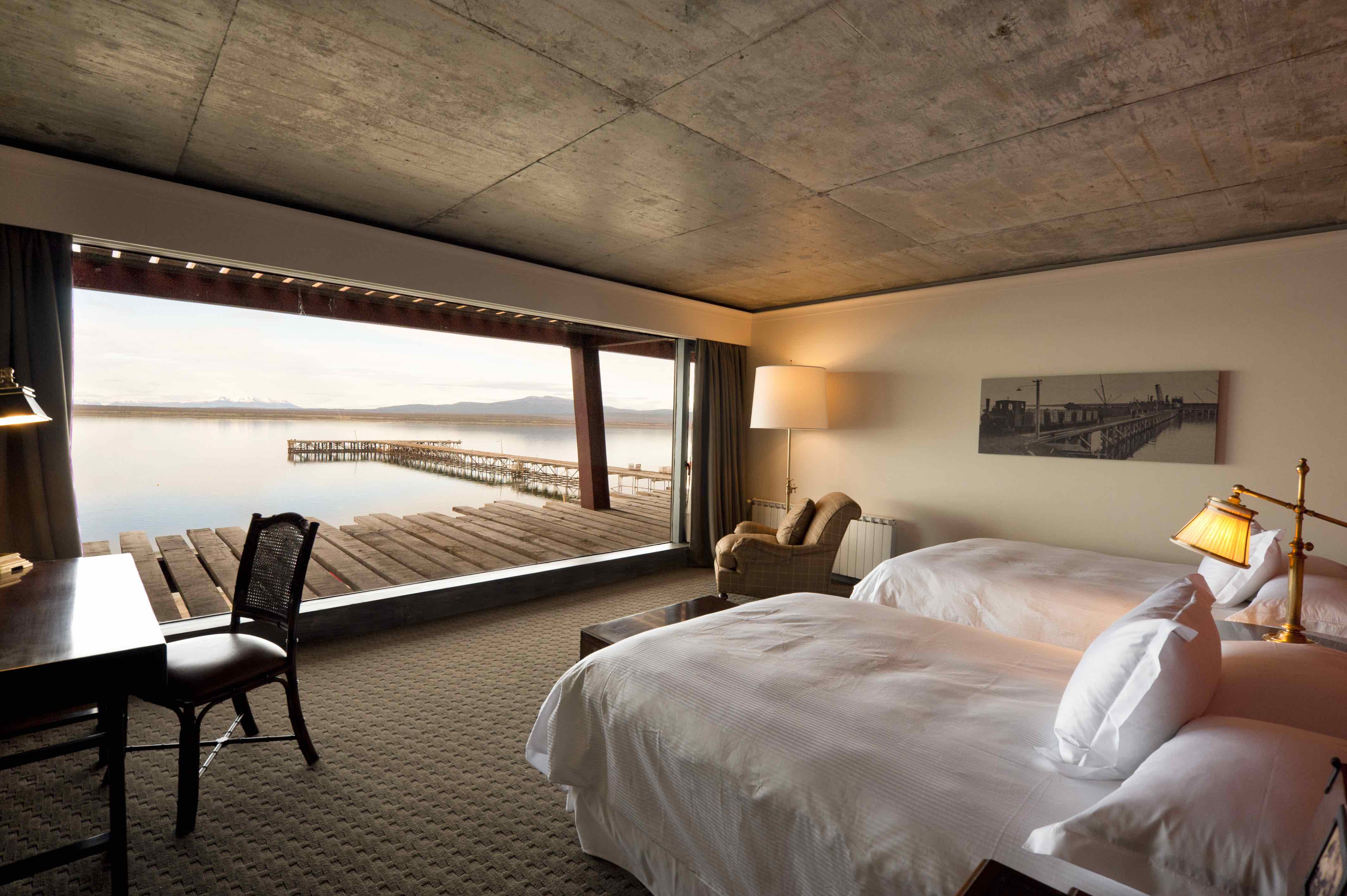 There are 54 rooms and three suites, from US$400 a night, each with six-metre wide picture windows, custom furniture, plush beds and free high-speed wifi.
There are 54 rooms and three suites, from US$400 a night, each with six-metre wide picture windows, custom furniture, plush beds and free high-speed wifi.

The property offers unparalleled access to wilderness – guests can take boat trips through the fjords, go horse riding, kayaking, bird watching, trekking and fly fishing. Local Chilean wines and Patagonian barbecue are served in the former blacksmiths. There are also heated indoor and outdoor swimming pools.
Forbes says: “The Singular Patagonia occupies a onetime sheep-processing factory, looks like a barn at first approach, and requires guests to traverse intact machine rooms and tannery facilities on their way to their rooms or to dinner.
“The austere exterior can be deceiving: The Singular is one of the most indulgent hotels anywhere, all the more so for being under the moody clouds and brilliant slanted sunshine at the end of the world.”
3. Ion Adventure hotel, Iceland
 With easy access from the UK, the US, Canada and Northern Europe, Iceland has seen tourism surge from 300,000 in 2003 to almost 1.3 million international visitors in 2015.
With easy access from the UK, the US, Canada and Northern Europe, Iceland has seen tourism surge from 300,000 in 2003 to almost 1.3 million international visitors in 2015.
Despite a reputation for being expensive, the rugged island of Iceland has become a stalwart on every traveller’s hotlist. It’s natural landscape provides the big lure – with other-worldly thermal springs, glaciers, black beaches, waterfalls, ice caves, lava fields, volcanoes and geysers.
When it comes to the “experiential” travel trend, seeing the Northern Lights has become one of the must-see phenomena for the traveller of today. And despite not being guaranteed, travellers are willing the take the gamble. A recent survey by totallymoney.com found that it was the number-one “bucket list” activity across the world.
Although just 40 minutes’ drive from Reykjavik, the Ion feels extremely remote – it has stark, modern architecture, which is juxtaposed with a lunar landscape, extended periods of light and dark, extreme climate and magical atmospheric conditions. The property was unveiled in 2013.
Equally, the wealth of outdoor pursuits will appeal to the same kind of consumer. As travellers become more intrepid, the trend has shifted away from returning to places you love, to the discovery of new places. For every tourist who has “done” Iceland, the Norwegian Arctic Circle will be the logical next step.
The four-star Ion is a member of the Design Hotels collection, which was taken over by Starwood Hotels and Resorts, and which is now, of course, part of Marriott International. The hotel’s tagline is “Where everything meets nothing.”
Close to Thingvellir National Park, the property is on the Golden Circle route, which also takes in Gulfoss waterfall and the Great Geysir. Tapping into the trend for sustainable, responsible travel, the property is built on recycled and renewable materials and draws its heat and power from surrounding hot springs.
The hotel has 45 rooms. However, it should be noted that when you find hyper minimalist architecture in equally barren landscape, guests will be looking for warm, inviting interiors. The hygge factor is essential – so popular has this Danish concept become, it has was shortlisted by the Oxford English dictionary as “word of the year” in 2016. The word has its roots in the 16th-century Norwegian word hugga, which is related to the English word “hug”.
A review in The Telegraph reads: “This oblong-shaped hotel, jutting out from the base of a long-dormant volcano, affords striking views of the other-worldly landscape. Inside the look is stylish, contemporary and minimalist, with exposed concrete walls and wooden furniture (think Scandinavian-chic).
“Wire-framed chairs draped with animal throws dot the lobby, which in turn is decorated in subdued colours and lit with hanging lamps. The interiors will no doubt delight lovers of design but those in search of cosy character will be disappointed.” Rates are from £380 a night.
4. Fogo Inn, Newfoundland
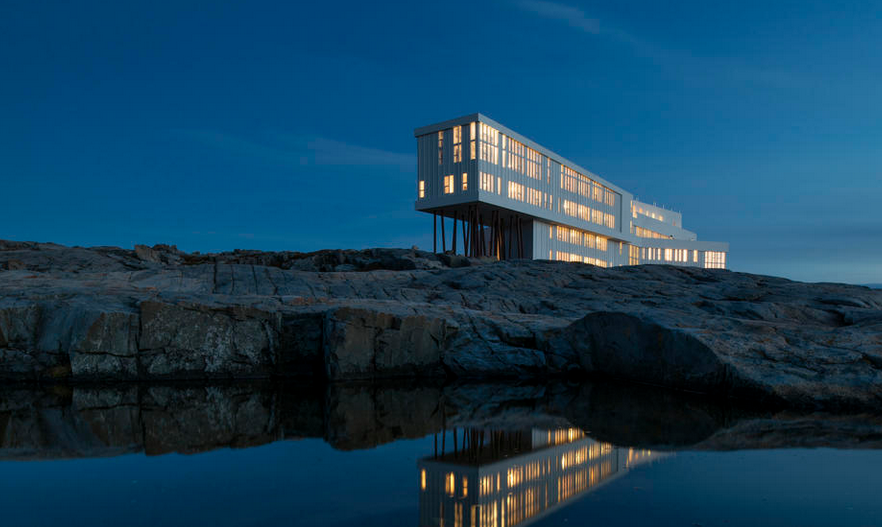 Designed by Norwegian practice Saunders Architecture and built in 2013, the Fogo Island Inn is distinctly reminiscent of the Ion in Iceland. “Find yourself at one of the four corners of the Earth”, its website reads. The white, X-shaped structure is supported by stilts, lifting it just above the craggy rock and roiling surf beneath it. Located just off the north-east coast of Newfoundland, in Canada, the hotel describes its positioning as “remote yet accessible”.
Designed by Norwegian practice Saunders Architecture and built in 2013, the Fogo Island Inn is distinctly reminiscent of the Ion in Iceland. “Find yourself at one of the four corners of the Earth”, its website reads. The white, X-shaped structure is supported by stilts, lifting it just above the craggy rock and roiling surf beneath it. Located just off the north-east coast of Newfoundland, in Canada, the hotel describes its positioning as “remote yet accessible”.
Newsweek writes: “The Fogo Island Inn is the largest, whitest rebuttal to man’s vanity seen in this part of the world since the iceberg that sank the Titanic.”
Forbes Life writes: “If the place is gloriously dislocating at first, Fogo Island Inn immediately grounds you with its indigenous beauty. The restaurant deftly uses forage-to-table ingredients – a shoreline leaf that tastes like an oyster and the surprisingly good caribou moss – to demonstrate that the rock-ribbed landscape seen through the double- height dining room windows is not quite as barren as it seems.”
All around is the wild North Atlantic ocean. Fogo Island is just 35km from east to west, and has a population of just over 2,000 people. “Although located just over halfway between the equator and the North Pole, the Labrador Current passing by Fogo Island’s doorstep brings with it the makings for a subarctic landscape and a temperate maritime climate.
“The Island’s boreal forest plays host to herds of caribou, beavers, foxes, mosses, grasses, and wildflowers. Migrating whales and icebergs visit in the spring, and fall’s berry season finds Fogo Island carpeted in at least two dozen varieties of edible berries,” says the Fogo Island Inn.
 The closest international airport to Fogo Island Inn is Gander, Newfoundland. Travellers can fly from Halifax and St John’s with Air Canada or United, with connections from Toronto, New York, Boston and London Heathrow. A passenger and vehicle ferry serves Fogo Island several times a day. The crossing takes about 45 minutes.
The closest international airport to Fogo Island Inn is Gander, Newfoundland. Travellers can fly from Halifax and St John’s with Air Canada or United, with connections from Toronto, New York, Boston and London Heathrow. A passenger and vehicle ferry serves Fogo Island several times a day. The crossing takes about 45 minutes.
After the collapse of the fishing industry (something the Norwegians can relate to), millionaire Zita Cobb returned to her home of Fogo Island in the noughties determined to create a reason for people to visit it. She said: “We saw an opportunity to use architecture as a way to preserve some of the things we were afraid of losing in terms of traditional knowledge. To not just hold on to the knowledge, but actually extend it another 100 years.”
First she employed Canadian architect Todd Saunders to build a series of cutting-edge artists’ studios; then she set to work on the Fogo Island Inn, which showcases their work and pulls in tourists.
Cobb said: “We invited designers to come in for a residency and paired them up with local craftspeople, whether they be textile people or boat-building people, and asked them to come up with the objects that were needed. We don’t need to sell millions of anything, but selling 100 quilts makes a difference to Fogo Island’s economy.”
The design of the hotel is “radically contemporary”. It has 29 suites decked out in exclusively natural materials (wool, cotton, linen, wood); there is no plastic except for the phones. There is also first-floor art gallery and a library of both fiction and non-fiction books (tapping into the “IQ economy” trend), a 37-seat cinema, wood-fired sauna, al fresco hot tubs and a dining room from which you can gaze at icebergs at breakfast. Rates are from US$1,170 a night.
5. Tree hotel, Sweden
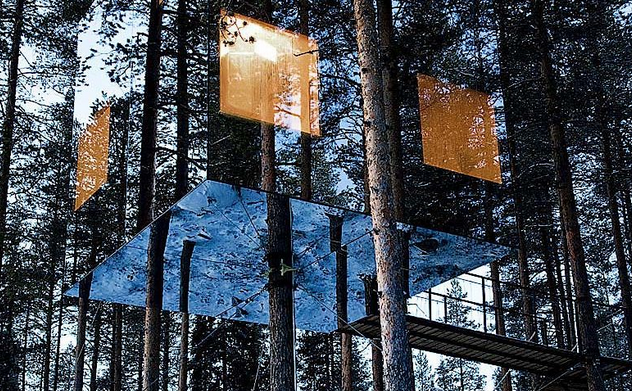 Featuring seven tree houses each designed by a different Scandinavian architect, the famous Tree Hotel is an excellent example of the tantalising combination of imaginative modern building with pristine landscapes. It also scores points for being in ever-popular Sweden.
Featuring seven tree houses each designed by a different Scandinavian architect, the famous Tree Hotel is an excellent example of the tantalising combination of imaginative modern building with pristine landscapes. It also scores points for being in ever-popular Sweden.
It might not be easy to get to – Harads is 50km south of the Swedish Arctic Circle (a 90-minute flight from Stockholm) – but it’s on many people’s bucket lists of places to stay. (You only have to look at the trend for “cabin porn” to see how much British people fantasise about the idea of an isolated hideaway.) There is even a spin-off hardback coffee table book on it. The most popular social media tags associated with this trend are “Norway”, “Rustic”, “Snow” and “Modern”.
The Tree Hotel is entirely unique and highly Instgrammable, but also the kind of place that appeals to people’s desire to switch off from the outside world and the technological trappings that come with it. The peace of a snowy pine forest is a gift for burnt-out city dwellers. The Tree hotel proves that if you build something amazing, and they will come.
Created by wife-husband Britta and Kent Lindvall in 2010, the Tree hotel is built into the canopy of the forest, with futuristic tree houses connected by gangways.
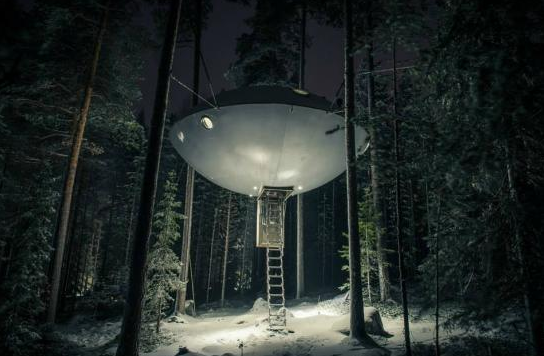 One residence, the MirrorCube, which was designed by Tham & Videgard, takes the form of a seemingly floating mirrored box but inside has a double bed, bathroom and living, as well as a roof terrace on top. Designed by Inrednings Gruppen and Bertil Harström, there is also the UFO and the Bird’s Nest, and the Blue Cone by Sandell Sandberg.
One residence, the MirrorCube, which was designed by Tham & Videgard, takes the form of a seemingly floating mirrored box but inside has a double bed, bathroom and living, as well as a roof terrace on top. Designed by Inrednings Gruppen and Bertil Harström, there is also the UFO and the Bird’s Nest, and the Blue Cone by Sandell Sandberg.
Sustainability and a sensitivity to nature are integral to its philosophy. A stay at the Tree hotel is about simplicity, harmony and rediscovering your sense of self. Meals are served in a nearby hostel so in winter guests have to trudge through the snow to get fed (unless they order room service) – but that’s the joy of it.
Luxury isn’t always about making people feel so pampered they become lazy, sloth-like, jaded and entitled; today’s travellers also like to feel they’ve worked for something, had an authentic experience they can talk about with friends.
The most recent addition to the woodland complex will be delivered by Snøhetta early this year (2017). With exteriors clad in charred timber, it will be the largest cabin at 55 sqm, and will even have a net for stargazing and observing the Northern Lights. As remote hotels go, this is one of our favourites. Rates from £450 a night.
